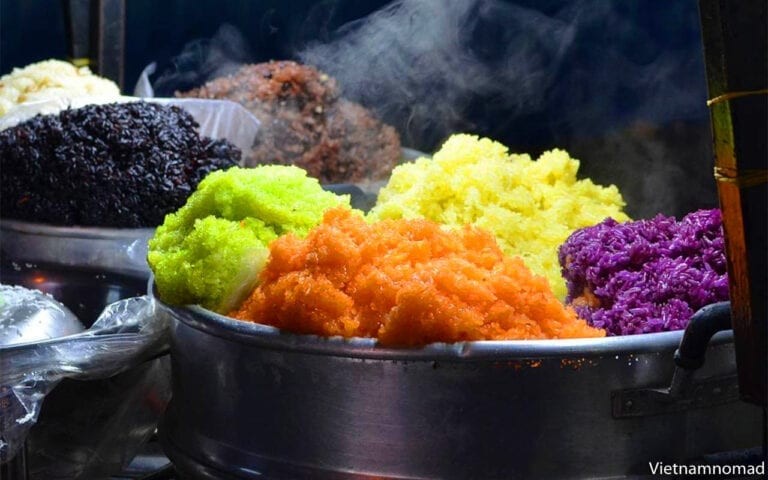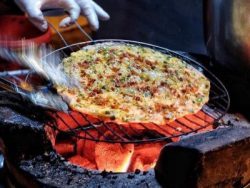Vietnam has been long known as a culinary paradise. To explore Vietnamese food is to dive into its diverse cuisine as not only does it always burst with flavors but also is an incarnation of a prosperous breadth of history. Here are the top 15 Vietnamese food you must try!
Pho has been serving as the “cultural ambassador” to promote Vietnamese cuisine throughout the years. It is no exaggeration to say that cooking Pho is a form of art for all the complicated steps and dedicated ingredients it requires. Anyone who has eaten Pho has to admit that the hot steaming broth is the soul of the dish which has many layers of flavor added to it. A qualified broth has to fulfill three strict criteria: first, the broth has to be clear to guarantee visual attractiveness; second, it has to come with the subtle sweetness extracted from the pork bones slowly cooked for hours; and third, it has to bring up the herby aroma of cinnamon, anise, ginger and so many more.
Pho can be found anywhere in Vietnam with a varied range of prices. To eat Pho like a local, season your bowl of Pho when it is served at your table with some fresh basil, coriander leaves, and blanched bean sprouts then squeeze in a few drops of lime juice. Get a small bowl and make the sauce for your Pho with a combination of soybean, chili sauce, and sauté; mix them up then dip the beef while you eat. You can also order a small bowl of a poached egg on the side as locals do to ensure the flavors and protein intake for the day.
2. Banh Mi
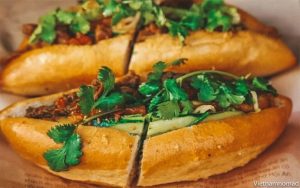
You cannot talk about Vietnamese cuisine without mentioning Banh Mi. Having received high praise from both eaters and critics, it is described as “a symphony in a sandwich” by the former professional chef Anthony Bourdain.
Adapted from the French baguette, Banh Mi is a crunchy bread stuffed with a wide range of fillings, which often are meat, eggs, carrot pickles, and herbs. Banh Mi is absolutely easy to go for as you can choose what to add in according to your preference. It can be found in any corner in Vietnam and is suitable to eat at any time of the day due to its high nutritional value. For only 15,000 VND (less than 1 USD), you will have a quality and delicious meal.
The creation of Banh Mi is unlimited; there are hundreds of versions of Banh Mi out there, which proves the awesome creative spirit of those Vietnamese street vendors. To eat Banh Mi like a local, accompany it with a cup of Ca Phe Sua Da (coffee with condensed milk) to bring up the taste of both.
3. Goi Cuon

Fresh spring rolls or Goi Cuon is another street food that could come in both vegan and non-vegan versions. Goi Cuon is not only filling but also portable, which makes it super convenient to eat on the go. Each roll is wrapped inside rice papers, stuffed with green veggies such as lettuces and Vietnamese basils; rice noodles, and carrots.
For meat-eaters, rolls can be added with sliced pork and shrimp. Its appearance is already catchy and vibrant with all the colors. At some restaurants, you can wrap your own rolls. To do it like a local: spread out a sheet of rice paper, wet it with some water before adding in all the mentioned ingredients then roll it tightly. It will take some effort but you will enjoy it on the way.
To eat Goi Cuon like a local, don’t forget to dip the rolls in one of the three sauces (are ranked in order of our recommendation): soybean paste sauce topped with ground peanuts; sweet and sour fish sauce with carrot pickles; or fermented fish sauce seasoned with minced pineapple. In any way, this summery snack should not be missed when you are in Vietnam.
4. Bun Bo Hue

In an episode of “Anthony Bourdain: Parts Unknown” on CNN, the famous American chef said: “Hue beef noodle is the best soup in the world.” The Asian Record Organization had also put Hue beef noodles into the top 100 delicious Asian dishes.
The name indicates its origin, which is from the Emperor City – Hue in Central Vietnam. It is a spicy beef noodle soup with the iconic color of annatto oil and the savory fragrance from the lemongrass saute. The cooking process of this noodle soup is time-consuming and requires not only cooking skills but also patience. The noodles used for this soup are unmatched: it is round and thicker than the usual rice vermicelli; the taste is extra due to the addition of sliced onions and Vietnamese coriander.
Locals often eat Bun Bo Hue with some vegetables such as banana flowers, bean sprouts, and a touch of lime juice.
Nowadays, you can enjoy a bowl of Bun Bo Hue anywhere, but a proper bowl must be enjoyed at a roadside restaurant near Trang Tien Bridge, Hue, where there are ” hundred-year-old heirloom” eateries.
5. Mi Quang

Speaking of delicious Vietnamese dishes, it is impossible not to mention Mi Quang, a dish that brings all the essence of Central Vietnamese cuisine. Mi Quang is a specialty that originated from Quang Nam – a province that owns two treasures of Vietnam: Hoi An Ancient Town and My Son Sanctuary. It is a convergence of different cultures in which you could find a hint of Japanese, Chinese, and Vietnamese cuisine blended together.
Unlike other kinds of Vietnamese soup, the broth in Mi Quang is not hot soup filled to the edge of the bowl. Actually, you cannot even see any soup from the surface, but it is particularly savory and fresh. The toppings have all kinds of proteins that you could think of. For a “special” bowl of Mi Quang, there are sliced pork, shrimps, and quail eggs. Mi Quang is not complete without a handful of green herbs, crispy “Banh Da” – a type of rice paper which is thick, cracky, and added sesame. It can also be served with your preferred protein such as chicken, fish, or even young chicken eggs.
Be aware of the complex ingredients in case you are allergic to any of them, and you can always customize your bowl of Mi Quang by telling the restaurant what kind of meat you would like.
6. Banh Xeo

Banh Xeo is probably another name that is all the rage among the Vietnamese street food checklist. The name “Banh Xeo” came from the sizzling sound when the turmeric yellow batter is poured into the hot pan. Banh Xeo comes in all shapes and sizes depending on the region: it is thinner, bigger, and less oily cooked in the South compared with the central version, which is more oily, but at the same time, crunchier.
Due to the popularity it has gained among foodies from all over the world, the fillings have been added to maximize the dining experience. Authentically, however, Banh Xeo is stuffed with pork belly, shrimp, bean sprouts, and mung beans. The “right” Banh Xeo batter is mixed with coconut milk, added garlic chives, and has to be fried in pork fat. Banh Xeo is no good as take-away food as what makes it really stand out is the dining vibes: the constant sizzling noise in the background, the scent of coconut milk, and turmeric powder as well as the vibrant talking of the eaters who gather to share not only food but stories.
To eat Banh Xeo like a local, take a wasabi leaf and stuff it with some other leaves of green herbs and some Banh Xeo, wrap them up and dip it in the sweet and sour fish sauce; complete it with some carrot pickles from the sauce, and enjoy.
7. Nem Ran
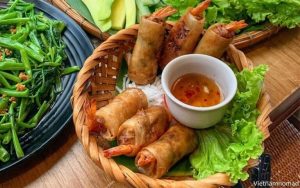
Vietnamese eating culture is all about gathering and sharing food. That’s why a host of our food comes in rolls, which are easy to share. And Nem Ran is one of those treats which could be found at any Vietnamese traditional celebration as an appetizer.
The filling for Nem Ran is actually not fixed, but basically, it is crammed with a paste of minced pork and shrimp, bean sprouts, chopped glass noodles, diced carrots, mushrooms and taros inside a rice paper, which is later deep fried to get the caramel look and crunchy texture. We are always aware of the principle of Yin and Yang, especially in our eating routines. Therefore, these deep-fried dishes are always accompanied with lots of green herbs and vegetables.
If you are allergic to seafood, you can order Nem Ran with pork stuffings only. Nem Ran can be eaten separately as a snack or an appetizer. However, you can also get a bowl of thin rice noodles, top it with herbs and sliced cucumber then add Nem Ran on the side but don’t forget to season it with some fish sauce.
8. Banh Cuon

The name means “rolled cakes” (although they are not really cakes). Banh Cuon is thin spreads of steamed rice batter stuffed with ground pork and chopped wood-ear mushrooms, presented on a bed of fresh cucumber, Vietnamese basils, and blanched bean sprouts. Although the ingredients are simple, the cooking process is incredibly mesmerizing, which requires perfect timing and skillful technique to lift off the steamer while still maintaining its perfect shape.
What tells the difference between one from another Banh Cuon is the homemade Cha Lua (Vietnamese sausages) and the dipping sauce. This is a light dish, which explains why it is traditionally eaten as breakfast. However, over time, because of its flavorful and healthy treat, Banh Cuon is served all day as an easy-going snack.
In many places, Banh Cuon is served together with Nem Ran (Cha Gio in the South), and Banh Tom (fried shrimp cakes).
9. Bun Cha
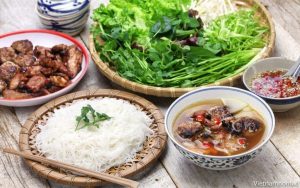
Bun Cha is quite a different dish in the way it is eaten. Basically, it is caramelized grilled pork and meatballs bathed in vinegary broth. That may sound simple but it is actually eye-popping good as the meat requires absolutely sophisticated seasoning techniques. It has to be pork shoulders with thin layers of fat so that it is not too dry when grilled. On the side, pork is minced to make pork cakes in little circular shapes, which are later grilled on a coal fire. The broth is the star itself because it has a hint of the vinegar sourness added with texture and flavor by the pickled carrots and green papayas. The dish is served with fresh vegetables of your choice.
A perfect bite comprises a bit of noodle, a slice of grilled pork, and pickles wrapped in some green leaves then well dipped into the sauce. Bun Cha definitely wakes up all your senses by a graceful balance of sweetness and sourness of dipping sauce and the freshness of rice vermicelli noodles and veggies. There are many ways to eat Bun Cha depending on the region (actually, we locals are confused sometimes). However, either of the following is the most popular way to eat: Wrap BBQ pork, some noodles, and other herbs in a big lettuce leave and dip it in the vinegary soup. Or, add all the ingredients bit by bit in a small bowl, wet it with some of the soup, and eat from the bowl.
10. Cha Ca
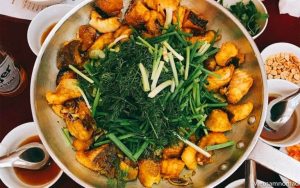
Cha Ca (grilled fish) is a specialty of Hanoi, which is made from hemibagrus – a freshwater fish with very few bones and tasty flesh. Cha Ca is served with vermicelli, coriander, scallion, basil, and dill. All together creates an unforgettable taste for anyone who has tried it once.
Normally, Cha Ca is dressed in a layer of corn powder and briefly fried before being served at the table and you enjoy while it is cooked on the oven, so it is always fresh and hot. To eat as we do, get a small bowl and pick up some rice noodles, greens, and fish meat. Don’t forget to season it with fish sauce or fermented fish sauce and peanuts.
11. Cao Lau

Cao Lau is another Vietnamese food that originated from Central Vietnam. Cao Lau took the form of Mi Quang, which has very little broth, making it more like a dry noodle dish than a soup. Although, nowadays, Cao Lau could be found anywhere, eating Cao Lau by the Hoai River in the heart of Hoi An would be a truly authentic Cao Lau experience that you cannot miss.
The noodles used for making Cao Lau are unique. They are udon-sized thick and ivory-ish. The color comes from the special tree bark ash particularly found on Cham Island – a small island off the coast of Hoi An. Cao Lau is served in a bowl with green baby mustard leaves and other herbs and Char Siu pork, which really adds flavor to it.
Cao Lau is already fully seasoned itself, we don’t often season it at the table as with other dishes, but you can always add in some chili if you like it a bit spicier.
12. Xoi

Xoi or steamed glutinous rice is an indispensable dish in Vietnamese cuisine. Every Vietnamese growing up has eaten a load of Xoi wrapped in banana leaves. There are various types of Xoi as you can imagine. Generally, the ingredients included in making Xoi are varied yet often combined with vibrant natural coloring and flavoring such as pandan leaves, gac fruit (which is a reddish melon), and magenta leaves. Xoi is also combined with all kinds of beans: green beans, black beans, peanuts, and so on.
A more nutrition-packed version is known as Xoi Man – a savory dish loaded with toppings on the bed of jasmine-scented sticky rice. It is a perfect balance of pork flosses, dried baby shrimps, Vietnamese salami, salted white carrot, fried onions, quail eggs, and smashed peanuts. Xoi is sold from big, steamy pots on the side of the streets. You cannot miss the sight of a puff of scented smoke rising from colorful steamers and it is absolutely worth putting on your must-try list.
As a local, it is best to eat Xoi wrapped in banana leaves to get a special flavor steaming out from the leave combined with the natural flavor of Xoi.
Along with Banh Mi, Xoi is the soul of Vietnamese street food, the food that every Vietnamese love.
13. Hu Tieu
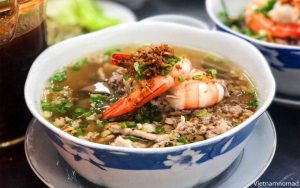
Hu Tieu is cooked with thin squared noodles which is a local delicacy of the South. Used to be praised by the celebrity chef Gordon Ramsay as the best broth he’s ever tasted; its broth is slow-cooked with pork bones and ribs on a beehive-coal fueled oven to get that elegant and light sweetness.
When being ordered, the cook blanches Hu Tieu noodles in a separate pot of boiling water before presenting them in the bowl with blanched bean sprouts, lettuces, and sliced pork. It sometimes could be seen topped with minced pork, meatballs, and quail eggs also, which is known as Hu Tieu Nam Vang. Each then seasons the bowl of Hu Tieu in their own way, but normally with a touch of lime juice and chili sauce.
In different regions, Hu Tieu is served with different kinds of pickles such as pickled garlic or chilies. But the original pickles which are served in the Mekong Delta is Do Chua (pickled daikon). If the restaurants serve your Hu Tieu with this pickle, you know you are having an authentic bowl of Hu Tieu.
14. Ca Phe Sua Da

Believe it or not, you would happen to say this word at least once when you are in Vietnam since who will ever miss this refreshing drink, especially on a hot day during the humid climate in Vietnam? Ca Phe Sua Da is basically iced black coffee mixed with condensed milk. Its popularity has probably surpassed the traditional black coffee as it is a little sweet and creamy while still having a good caffeine kick.
Ca Phe Sua Da is made from Vietnamese coffee (Robusta coffee) with a small metal Vietnamese drip filter (called a phin). Add about 1-2 teaspoons of coffee to phin, then pour about 50 – 100 ml of hot water; the phin releases drops of hot coffee into a cup. Vietnamese people (especially Saigon people) often drink coffee with milk instead of sugar; they usually add 1 – 2 tablespoons of condensed milk.
You can customize your drink by asking for more or less milk. Iced tea is often served along to help you balance out the sweetness. You can also drink Ca Phe Sua Da with your favorite Banh Mi.
15. Ca Phe Trung

Everyone knows that Vietnam is the land of coffee beans and coffee shops. But we had brought coffee to the next level with the egg coffee – a cup of hot black coffee topped with rich and creamy whipped egg yolks. It is probably not easy to picture egg and coffee together, but this is a real treat that has a subtly sophisticated balance as Vietnamese black coffee is often pretty strong, so the egg form layer is intended to sweeten it in a gentle way.
You can enjoy Ca Phe Trung in many places in Vietnam, but a cup of coffee at Giang Cafe will be a great choice if you are in Hanoi, where you can find an original taste of egg coffee.
Some may consider Ca Phe Trung as a dessert for its rich sweetness and creamy taste so you may want to have it after your main meal.
A few notes
Unlike in Western countries where food is designated for each particular meal, these dishes are available everywhere in Vietnam and can be eaten anytime during the day, but the flavor may vary from region to region:
Northern Vietnamese cuisine focuses on Yin and Yang and the Five Elements; you can see the same Pho, but in the North, it is more flavorful and elaborate than in the other regions. Northern people also minimize the seasoning and addition of herbs.
The food in Central Vietnam is relatively saltier and spicier than in other regions, typically Mi Quang and Cao Lau.
For the South, especially in the Mekong Delta, the dishes are usually sweeter as the sincerity and warmth of the people of the Delta.
Should you tip at a restaurant in Vietnam?
To be honest, in Vietnam, we don’t have (or very little) “tip culture”. So if you eat in small or medium eateries, you don’t need to worry about it; just pay the right amount on the menu. Of course, you can tip a small amount if you wish to (we’re sure the server would be happy too) but note that it is not necessary.
Big restaurants usually apply 5 – 10% of service fees to your bill; therefore, there is no need to tip here.
However, if a dish or service exceeds your expectations, the tips of about $2 (50,000 VND) would be acceptable, right?
Source : Vietnamnomad

